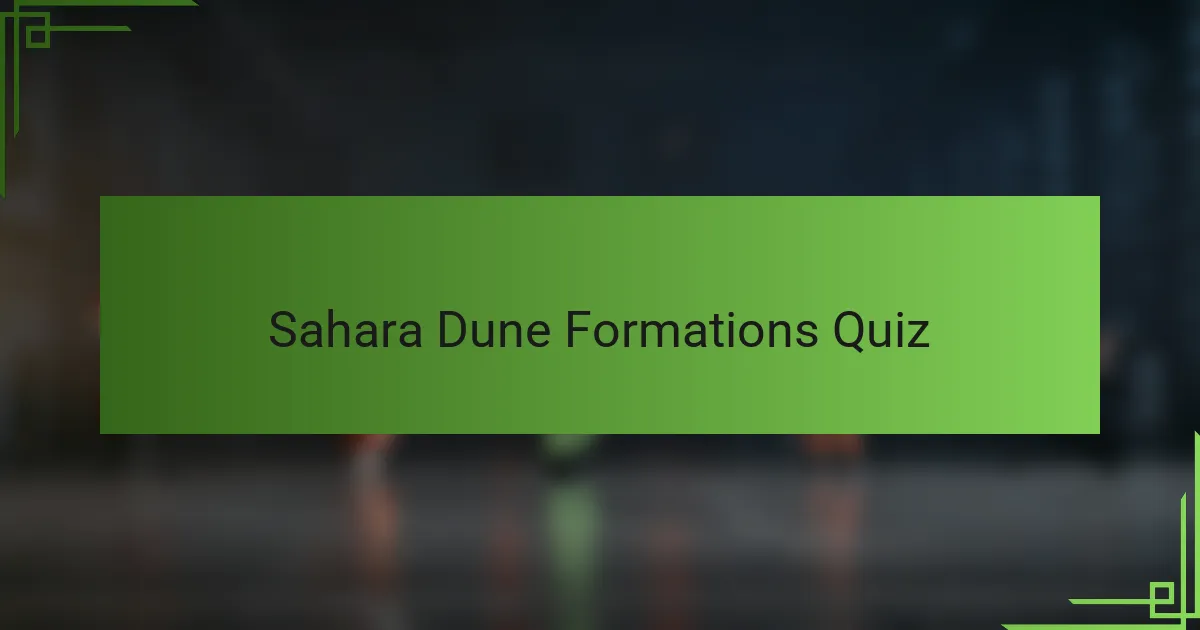
Sahara Dune Formations Quiz
1. What is the name of the tallest dune in the Sahara Desert, located in Algeria?
- Dune of Taghit
- Dune of Ez-Zib
- Dune of Erg Chebbi
- Dune of Tifoujar
2. Which Sahara dune formation is known for its crescent shape and is commonly found in the region?
- Seif dune
- Star dune
- Barchan dune
- Linear dune
3. What is the term used to describe large dune fields found in the Sahara, such as the Grand Erg Oriental?
- Erg
- Reg
- Hamada
- Sabkha
4. Which mountain range in the Sahara is famous for its rocky plateaus and dune systems?
- Ahaggar Mountains
- Aïr Mountains
- Tibesti Mountains
- Tassili n`Ajjer
5. What Sahara dune formation is characterized by linear ridges and is often aligned with the prevailing winds?
- Barchan dunes
- Parabolic dunes
- Star dunes
- Seif dunes
6. In which Saharan country is the sea of dunes called the Erg Chebbi located?
- Libya
- Morocco
- Tunisia
- Algeria
7. What is the name of the Sahara dune system that lies largely within Mauritania and is a UNESCO World Heritage Site?
- Tassili n`Ajjer
- Adrar Plateau
- Erg Chebbi
- Banc d`Arguin National Park
8. Which Sahara desert feature consists of star-shaped dunes formed by multidirectional winds?
- Dome dunes
- Linear dunes
- Star dunes
- Barchan dunes
9. What is the name of the sandy desert area in the central Sahara, known for extensive dune fields in Libya?
- Tenere Desert
- Nubian Desert
- Libyan Desert
- Erg Chech
10. Which large erg in the Sahara Desert spans parts of Algeria and Tunisia and is known as the Grand Erg Occidental?
- Issaouane Erg
- Grand Erg Occidental
- Grand Erg Oriental
- Erg Chech
11. What type of dune formation in the Sahara resembles a crescent and is often called a barchan dune?
- Parabolic dune
- Star dune
- Barchan dune
- Linear dune
12. What is the name of the desert in Chad that contains extensive dune formations and is part of the Sahara?
- Erg Chech
- Ténéré Desert
- The Bodele Depression
- Ennedi Plateau
13. Which Saharan dune formation is notable for its longitudinal dunes stretching parallel to wind direction?
- Barchan dunes
- Seif dunes
- Star dunes
- Transverse dunes
14. What Sahara dune area is renowned for its vast white sand dunes located near the Algerian town of Timimoun?
- Grand Erg Oriental
- Grand Erg Occidental
- Issaouane Erg
- Erg Chebbi
15. In the context of Sahara dunes, what is an `erg` and how does it differ from a `reg`?
- An erg is a rocky plateau, and a reg is a sand dune formation that shifts with wind.
- An erg is a desert oasis formed by groundwater, while a reg refers to salt flats in the Sahara.
- An erg is a large sea of sand dunes, while a reg is a stony desert surface covered with gravel and pebbles.
- An erg is a dry riverbed in the desert, whereas a reg is a flat sandy plain without dunes.

Congratulations on Completing the Sahara Dune Formations Quiz!
You’ve just explored some fascinating aspects of the Sahara’s dune formations. Through this quiz, you likely gained a clearer understanding of how these unique landforms shape one of the world’s largest deserts. From the different types of dunes to the processes behind their formation, these insights deepen your appreciation of desert geography.
Engaging with this quiz also helps you recognize the dynamic nature of Earth’s landscapes. The Sahara is not just endless sand; it’s a complex environment with shifting sands and evolving patterns. Understanding such features is essential for grasping how natural forces act over time, influencing both the terrain and the ecosystems within it.
If you found this quiz intriguing, we invite you to explore the next section on this page. There, you will discover even more detailed information about Sahara dune formations. This additional content will expand your knowledge and enhance your perspective on geographic phenomena in desert regions.

Sahara Dune Formations
Geographical Location and Extent of Sahara Dune Formations
The Sahara Desert, located in North Africa, spans over 9 million square kilometers, making it the largest hot desert in the world. Within this vast area, dune formations are prominent, especially in regions like the Libyan Desert, the Algerian Sahara, and the Erg Chebbi in Morocco. These dunes cover extensive surfaces, indicating wind-driven sediment redistribution over millennia, shaping vast ergs or sand seas. Their presence marks significant geographic zones where climatic and topographic factors promote sand accumulation and aeolian processes.
Types of Dunes Found in the Sahara
The Sahara contains several types of sand dunes, primarily barchan, transverse, star, and linear dunes. Barchan dunes are crescent-shaped and migrate eastward due to dominant northeasterly winds. Star dunes are prominent in the Libyan Desert’s Cedra Oasis region, characterized by multiple arms radiating from a central peak, formed under multidirectional wind patterns. Linear dunes, like those in the Ténéré region of Niger, extend for kilometers in parallel ridges. These types reveal diverse wind regimes and sediment availability within Sahara’s dune fields.
Formation Processes of Sahara Sand Dunes
Sahara dune formations originate through aeolian (wind-driven) processes. Winds lift and transport sand particles, depositing them when wind velocity decreases. Variability in wind direction and strength influences dune morphology; stable winds create uniform dunes like transverse dunes, while variable winds generate complex forms such as star dunes. The Sahara’s arid climate limits vegetation, allowing freer sand movement. Geological factors, such as ancient riverbeds and bedrock outcrops, also influence dune formation patterns by affecting sand supply and wind flow.
Role of Wind Patterns in Shaping Sahara Dune Morphology
Wind patterns critically shape the Sahara’s dune morphology. Predominant trade winds, such as the Harmattan blowing from the northeast, direct sand movement. In regions like the Libyan Desert, multidirectional wind regimes create star dunes with arms aligned to varying wind directions. In contrast, the western Sahara experiences more consistent trade winds, forming barchan and linear dunes that align perpendicular to wind flow. Seasonal variations also modulate dune activity, causing periodic shifts in dune shape and migration rates.
Significance of the Erg Chech and Erg Iguidi Dunes in Sahara Geography
The Erg Chech and Erg Iguidi are two of the largest dune fields within the central Sahara, located between Algeria and Niger. Erg Chech spans approximately 150,000 square kilometers and features extensive linear and star dunes. Erg Iguidi covers around 40,000 square kilometers predominantly with broad sand sheets and dunes. These erg regions serve as crucial indicators of past and present climatic conditions and illustrate the spatial distribution of sand within the Sahara. They impact local hydrology and human activity patterns, acting as geographic landmarks for navigation and settlement avoidance due to harsh terrain.
What are Sahara dune formations?
Sahara dune formations are large accumulations of sand shaped by wind action in the Sahara Desert. These dunes range in size and shape, including barchan, star, and longitudinal dunes. They form as wind transports sand, causing it to accumulate in areas with less wind velocity. The Sahara Desert, covering approximately 9.2 million square kilometers, contains some of the world’s largest dune fields such as the Erg Chech and Erg Oriental, where dunes can reach heights of up to 180 meters.
How do Sahara dune formations develop?
Sahara dune formations develop through aeolian processes, where wind erodes, transports, and deposits sand particles. Strong and consistent winds lift loose sand and move it downwind, creating patterns based on wind direction and sand supply. Variations in wind speed, direction, and obstacles like rocks influence the types of dunes formed. Over time, continuous sand accumulation leads to the growth and migration of dunes, as observed in the Grand Erg Oriental, where satellite imaging confirms dune movement of several meters per year.
Where in the Sahara are the most notable dune formations located?
The most notable dune formations in the Sahara are located in the Grand Erg Oriental and Grand Erg Occidental in Algeria, the Libyan Desert, and parts of the Ténéré Desert in Niger. The Grand Erg Oriental features vast sand seas with high dunes spanning around 250,000 square kilometers. These areas are well-documented by geological surveys and remote sensing data, which reveal extensive dune fields that dominate the landscape.
When did Sahara dune formations start to form?
Sahara dune formations began forming during the late Quaternary period, roughly since the last glacial maximum about 20,000 years ago. Climate changes caused fluctuations in rainfall and wind patterns, leading to desertification and extensive dune field development. Geological and sedimentary evidence, including optically stimulated luminescence dating of sand grains, supports this timeframe for the initiation of major dune formation phases in the Sahara.
Who studies Sahara dune formations?
Geographers, geomorphologists, and climatologists primarily study Sahara dune formations. Researchers from institutions like the University of Paris, the National Centre for Scientific Research (CNRS) in France, and the Sahara Desert Research Institute use field surveys, satellite imagery, and climate models to analyze dune dynamics. Their work is published in scientific journals such as the Journal of Arid Environments, providing validated data on dune morphology and environmental impact.
